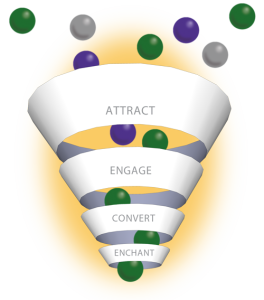10 Steps to Small Business CRM Design and Implementation Success
If you’re reading this post, you’ve probably already determined that you need help to make your sales and customer service processes more effective, efficient and scalable. The Excel spreadsheet filled with contact names just isn’t helping you stay connected with an ever-expanding list of leads, prospects and customers. You need help. You need a CRM.
Whether you are implementing a CRM for the first time – or are ready to try again after a failed previous attempt – here are 10 steps to insure the success of your CRM implementation.
1. Embrace the commitment required for success
For most SMB’s, the monthly cost for a couple of CRM seats is less than $200. The low cost of entry is one of the reasons that CRM’s have become so popular to start – and stop.
The real investment in CRM implementation is the time and energy required to make it work for your business. If you’re taking a DIY approach, plan on a minimum of 80 to 160 hours of learning time to design and implement a CRM. If you’re hiring a consultant to help out, you can be fairly certain there will be two to three long meetings and dozens of emails, phone calls and chats. And CRM consultants are part of the investment. Expect to pay between $5,000 and $25,000 for design, implementation, training and follow-up.
While some CRM’s suggest that they work, “right out of the box,” don’t believe it. Without customization, they offer only a slight improvement over an Excel spreadsheet.
2. Identify the desired business outcomes
 You’re investing in a CRM to increase revenue, but to have a successful implementation your goals need to be more specific. Start by asking yourself this question. “What part of the sales funnel do I need to focus on first?” Do you want the CRM to help generate more leads at the top of the funnel, or are you looking to increase renewal and referral business at the bottom?
You’re investing in a CRM to increase revenue, but to have a successful implementation your goals need to be more specific. Start by asking yourself this question. “What part of the sales funnel do I need to focus on first?” Do you want the CRM to help generate more leads at the top of the funnel, or are you looking to increase renewal and referral business at the bottom?
By focusing your CRM efforts on the one or two sales processes that will drive the most revenue, you will dramatically improve the probability of success. Ignore all of the cool things a CRM can do and focus on the core things you need it to do.
3. Establish your key performance indicators
At 2.0heads our mantra is, “if you can’t measure it, you can’t improve it.” No truer words were spoken about a successful CRM deployment! As you plan the CRM implementation, define the KPI’s (Key Performance Indicators) that will help measure whether the CRM is making your sales and customer service processes more effective and efficient. For example, assume your CRM goal is to increase repeat and referral business. Upstream KPI’s might include an increase in the number customers signing up for a monthly newsletter, or a decrease in customer service issues. All of this data can be captured in and reported out of the CRM, if the KPI’s are defined in advance.
Of course, you’ll also want to track standard sales metrics such as total revenue, average size of a sale, and closing ratio. This data can then be correlated against your upstream KPI’s, providing further evidence of the CRM’s effectiveness, or lack thereof.
4. Find a CRM Partner who thinks business first, and CRM second.
Virtually all of the popular CRM’s are structured in fundamentally the same way. Configuring the CRM to meet your needs will require little or no coding. In fact, configuring a CRM is often referred to as, “clicks, not code.”
Because configuring a CRM is fairly simple, the most effective CRM consultants are those who have:
- Deep experience in sales and customer service process development
- Business analysis and marketing expertise
- Process and workflow development skills
A CRM, as a piece of software, is no more complicated than Microsoft Word or Outlook. Great CRM partners are those who understand your business, understand sales, and can configure the tool to your specific needs. Look for an advisor who begins the conversation with questions about your business, not statements about his prowess as a coder.
5. Evaluate your current workflow.
Once you’ve partnered with a CRM consultant, the two of you should map out the current sales and customer service workflows for the organization. The more closely the CRM integrates into your current workflow, the fewer adjustments users will have to make.
For example, all CRM’s have the ability to send, receive and track emails from within the platform. The ability to associate specific emails with individual or multiple contacts is one of the most powerful features of a CRM.
Yet, if you’re an Outlook user there is a fairly good chance that you won’t want to use the CRM’s built-in email function. Chances are you would prefer to use Outlook while maintaining the ability of the CRM to associate emails with appropriate contacts.
Can it be done? Absolutely! But, the time to know that Outlook is a must-have is before the choice of a CRM is made and customization occurs.
6. Determine the CRM that best suits your needs.
With so many CRM choices available, and with all of them sharing similar functionality, it makes sense to choose a specialist before you commit to a particular CRM. A smart consultant will be familiar with most of the vendors. Once they understand your business and CRM needs, an appropriate list of good/better/best choices can be presented for your consideration.

7. Create one or two simple reports that measure your KPI’s over time
A quick question for you. How often do you refer to your website’s Google Analytics? If you’re like most small business owners, you rarely if ever look at them. Why? The reports are difficult to access, they tend to be complicated and you’re often unsure how the information relates to your business.
The same can be said for many of the canned reports available in your CRM. Because you’ve established your KPI’s in Step 3, it’s important to have your CRM advisor design one or two simple reports that provide context to these numbers with the click of a button.
8. Develop a roll-out and training plan
As your CRM design nears completion, and the process of uploading contacts and testing begins, a roll-out and training plan will need to be created. Obviously, if there are only one or two users, a formal document is probably not required. However, if you’ve got four or five team members across different departments who will be using the system, the extra investment to prepare a formal roll-out document will be money well spent. As new employees are added, the document will serve as a handy guide to bring them online.
Most consultants will emphasize the importance of user training, and we’re no exception. While extensive online documentation exists for all CRM’s, it’s important that users are given an immersive, hands-on tutorial covering the core functionality. Before training begins, users should be asked for a list of the common tasks that they would like to see demonstrated to insure that individual needs are fully addressed.
Indeed, nothing puts the brakes on CRM adoption faster than frustrated users. This is why we recommend your consultant’s agreement includes 30 days of on-demand phone, chat or interactive help after the initial roll-out. Users who know they can call for help become CRM advocates rather than protagonists.
9. Measure your KPI progress on a weekly basis
To maintain your commitment to the CRM and to insure that your company is accruing a return on its investment, KPI reports should be reviewed with users on a weekly basis. A typical scenario would be to request that users update all records by Sunday evening, allowing you to run your reports on Monday morning with fresh, clean data.
Reporting might be one of the last steps, but in many ways it’s the most important step of the CRM implementation process. Without engaging in a regular review of the KPI’s, adoption will normally fall off, rapidly decreasing the value of the CRM. Remember, what gets measured gets done!
10. Perform a 30 and 60-Day Review with your CRM Advisor
As you work with the CRM for the first 30 days, jot down any problems, wasted key strokes or impediments to your using the system. These items will serve as the punch list from which changes to the structure or workflow can be made. Even the most carefully planned CRM design will require adjustment as real-world use demonstrates the strengths and weaknesses of the first implementation.
A thoughtful advisor will make 30 and 60-day adjustments a part of his service and won’t hesitate to make on-the-fly tweaks to enhance the user experience and your satisfaction along the way.
In the end, a well-designed properly deployed CRM can measurably increase revenue by leveraging a business owner’s time, expertise and insight across a much broader audience of prospects and clients. Once the province of only the largest companies, CRM’s can be a powerful tool for small and medium-sized businesses looking to increase revenue, improve customer service and to scale and grow.


